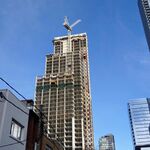U
unimaginative2
Guest
Sugar adding to waterfront's sour look
JOHN BARBER
People say that nothing is happening on the waterfront -- and they're mostly right. Despite a smattering of local improvements, huge tracts remain amazingly derelict -- most prominently the parking lots and old sheds of the central waterfront east of Yonge Street.
But government isn't alone to blame. An arrangement with private enterprise has done its share in retarding progress.
An overdue renaissance to the west remains paralyzed in utero due to the all-important need to shuttle a few dozen people a day back and forth to Ottawa.
Across the bay, the regulations that Redpath Sugar lobbied for maintain the long tradition of keeping all neighbouring development at bay.
In addition to their roles in retarding a waterfront renaissance, the island airport and the sugar plant share one significant characteristic: They are uneconomic.
If the free market had its way, both facilities would have gone the same way as the flour mills, shipyards, warehouses and foundries that once crowded the same shores.
Only political friction keeps them alive.
Although it has suffered none of the bad publicity richly earned by the Toronto Port Authority and the island airport, the Redpath plant is another prominent dog in the manger -- albeit one that offers a wonderful view down Jarvis Street when there's a ship unloading, and which will be missed when it closes, as it surely will.
Its inevitable end will mark the final demise of Toronto's industrial waterfront. Once Redpath closes, there will be no more foreign cargo ships inching dramatically through the Eastern Gap on a summer's day. There will be no more Harbour.
It could happen imminently -- perhaps as soon as Fidel Castro dies.
The moment the United States lifts its trade embargo on Cuba, as the whole world hopes and expects it to do, the last fragile reason for refining sugar on the Toronto waterfront disappears. Cuban sugar imported to Toronto will go through Miami, as God and Adam Smith intended. In the best of all possible worlds, it will be refined in Cuba.
In the meantime, the Redpath regulation is frustrating neighbouring property owners and preventing them from building what the market really does want -- apartments -- the construction of which can be leveraged to yield amenities such as a continuous waterfront promenade, new parks and gathering places.
I can't tell you exactly why the last scheme to develop the scandalously vacant lot at the foot of Yonge Street fell apart, but its legacy includes regulations that are guaranteed to make a mess of whatever might happen to the latest attempt. Anxious that new neighbours would besiege it with complaints about its trucks operating at night, the company successfully argued for a bylaw that requires any new development to be shielded from its yard by a four-storey wall -- and forbids it to include any east-facing windows.
It's hard to imagine a better example of a perverse political outcome that has done so much to retard waterfront development. But there it is: the law of the land. Let us adorn the face of our fair city with huge, blank concrete walls.
Maybe if Fidel dies before council has a chance to approve such a scheme, Redpath will hedge its bets by allowing for the inevitable. There is already one plan afoot for developing the Yonge Street half of the site. Building the other half under the current constraints would be disastrous.
The big difference between Redpath and the island airport is that nobody will miss the latter when it goes. But neither escapes the deathwatch. Unless there is no limit to waterfront absurdity, there can't be any future in using that much prime land for the trivial purpose of allegedly saving a handful of people a few minutes in the air.
If there was a real demand for the service, Porter Airlines wouldn't be struggling along with half-empty planes on two domestic routes, heavily dependent on government subsidies and patronage. The island airport would be a real going concern. But it hasn't been that for ages, and it still isn't. It's as obsolete as the sugar refinery across the bay, and like it sustained by politics alone.
jbarber@globeandmail.com
-----------------------------------------------------------
The city's planning process actively supports maintaining Redpath in its current location as part of the "industrial heritage" of the Toronto waterfront.
JOHN BARBER
People say that nothing is happening on the waterfront -- and they're mostly right. Despite a smattering of local improvements, huge tracts remain amazingly derelict -- most prominently the parking lots and old sheds of the central waterfront east of Yonge Street.
But government isn't alone to blame. An arrangement with private enterprise has done its share in retarding progress.
An overdue renaissance to the west remains paralyzed in utero due to the all-important need to shuttle a few dozen people a day back and forth to Ottawa.
Across the bay, the regulations that Redpath Sugar lobbied for maintain the long tradition of keeping all neighbouring development at bay.
In addition to their roles in retarding a waterfront renaissance, the island airport and the sugar plant share one significant characteristic: They are uneconomic.
If the free market had its way, both facilities would have gone the same way as the flour mills, shipyards, warehouses and foundries that once crowded the same shores.
Only political friction keeps them alive.
Although it has suffered none of the bad publicity richly earned by the Toronto Port Authority and the island airport, the Redpath plant is another prominent dog in the manger -- albeit one that offers a wonderful view down Jarvis Street when there's a ship unloading, and which will be missed when it closes, as it surely will.
Its inevitable end will mark the final demise of Toronto's industrial waterfront. Once Redpath closes, there will be no more foreign cargo ships inching dramatically through the Eastern Gap on a summer's day. There will be no more Harbour.
It could happen imminently -- perhaps as soon as Fidel Castro dies.
The moment the United States lifts its trade embargo on Cuba, as the whole world hopes and expects it to do, the last fragile reason for refining sugar on the Toronto waterfront disappears. Cuban sugar imported to Toronto will go through Miami, as God and Adam Smith intended. In the best of all possible worlds, it will be refined in Cuba.
In the meantime, the Redpath regulation is frustrating neighbouring property owners and preventing them from building what the market really does want -- apartments -- the construction of which can be leveraged to yield amenities such as a continuous waterfront promenade, new parks and gathering places.
I can't tell you exactly why the last scheme to develop the scandalously vacant lot at the foot of Yonge Street fell apart, but its legacy includes regulations that are guaranteed to make a mess of whatever might happen to the latest attempt. Anxious that new neighbours would besiege it with complaints about its trucks operating at night, the company successfully argued for a bylaw that requires any new development to be shielded from its yard by a four-storey wall -- and forbids it to include any east-facing windows.
It's hard to imagine a better example of a perverse political outcome that has done so much to retard waterfront development. But there it is: the law of the land. Let us adorn the face of our fair city with huge, blank concrete walls.
Maybe if Fidel dies before council has a chance to approve such a scheme, Redpath will hedge its bets by allowing for the inevitable. There is already one plan afoot for developing the Yonge Street half of the site. Building the other half under the current constraints would be disastrous.
The big difference between Redpath and the island airport is that nobody will miss the latter when it goes. But neither escapes the deathwatch. Unless there is no limit to waterfront absurdity, there can't be any future in using that much prime land for the trivial purpose of allegedly saving a handful of people a few minutes in the air.
If there was a real demand for the service, Porter Airlines wouldn't be struggling along with half-empty planes on two domestic routes, heavily dependent on government subsidies and patronage. The island airport would be a real going concern. But it hasn't been that for ages, and it still isn't. It's as obsolete as the sugar refinery across the bay, and like it sustained by politics alone.
jbarber@globeandmail.com
-----------------------------------------------------------
The city's planning process actively supports maintaining Redpath in its current location as part of the "industrial heritage" of the Toronto waterfront.














